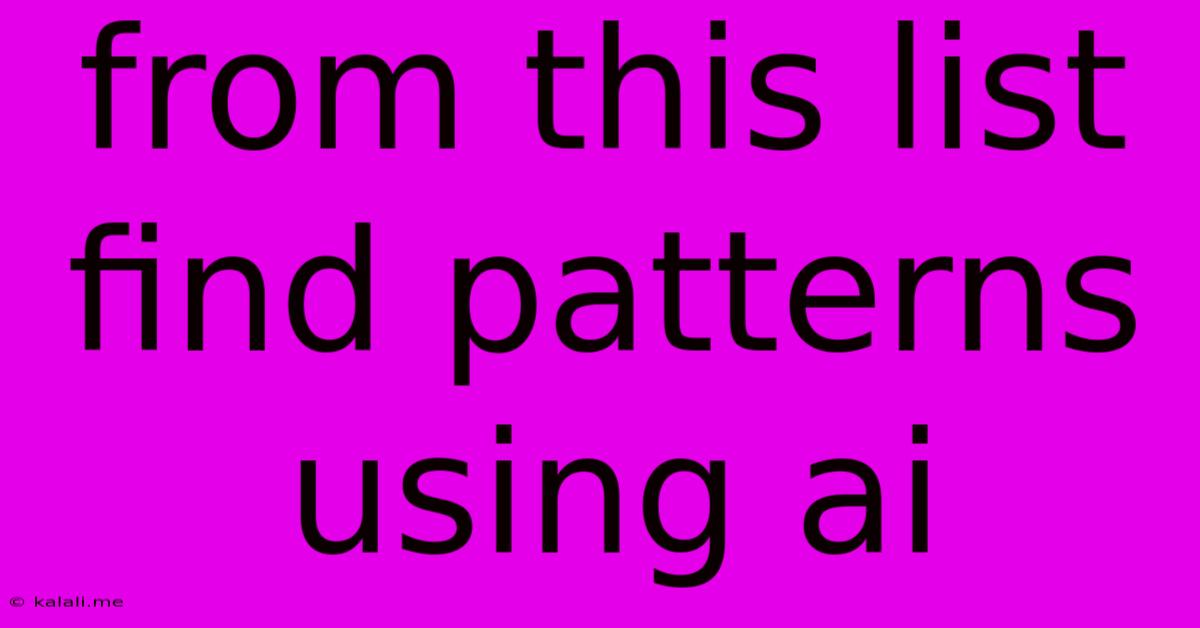From This List Find Patterns Using Ai
Kalali
Jun 09, 2025 · 3 min read

Table of Contents
Uncovering Hidden Patterns: Using AI to Analyze Data Lists
Finding patterns in large datasets can be a daunting task for humans. This is where the power of Artificial Intelligence (AI) comes into play. AI algorithms can quickly sift through massive amounts of data, identifying trends and patterns that might be imperceptible to the human eye. This article explores how AI can be leveraged to uncover valuable insights from seemingly random lists. We'll delve into different AI techniques and their applications in pattern discovery.
Why AI is Essential for Pattern Recognition in Data Lists
Manually analyzing large lists for patterns is incredibly time-consuming and prone to human error. AI offers several advantages:
- Speed and Efficiency: AI algorithms can process vast datasets in a fraction of the time it would take a human.
- Accuracy: AI reduces the likelihood of human error, leading to more reliable pattern identification.
- Complex Pattern Recognition: AI can identify intricate and non-linear patterns that might escape human observation.
- Scalability: AI solutions can easily handle increasing amounts of data, making them ideal for growing datasets.
AI Techniques for Pattern Discovery in Lists
Several AI techniques are particularly well-suited for finding patterns in lists. These include:
1. Machine Learning Algorithms:
- Clustering: Algorithms like K-means clustering group similar data points together based on their features. This is useful for identifying distinct categories or clusters within a list. For example, clustering customer data based on purchase history can reveal distinct customer segments.
- Classification: Supervised learning techniques like Support Vector Machines (SVM) and decision trees can classify data points into predefined categories. This is helpful when you have labeled data and want to predict the category of new data points.
- Regression: Regression models, such as linear regression, can identify relationships between variables in a list. For example, predicting sales based on advertising spend using historical data.
- Association Rule Mining (Apriori Algorithm): This algorithm is used to discover interesting relationships between variables in large datasets. It's particularly useful for finding frequent itemsets, such as products frequently bought together. For example, in a grocery store dataset, it can reveal that customers who buy diapers also tend to buy baby wipes.
2. Deep Learning Techniques:
- Recurrent Neural Networks (RNNs): These are effective for analyzing sequential data, such as time series data or text sequences. RNNs can identify patterns and trends within the sequence.
- Long Short-Term Memory (LSTM) networks: A specialized type of RNN, LSTMs are particularly good at handling long-range dependencies in sequential data, making them ideal for tasks like predicting future values in a time series or analyzing complex text patterns.
Practical Applications and Examples
The applications of AI in pattern recognition are vast and span various domains:
- Business Analytics: Identifying customer segments, predicting sales, detecting fraud, optimizing marketing campaigns.
- Healthcare: Diagnosing diseases, predicting patient outcomes, discovering drug interactions.
- Finance: Detecting fraudulent transactions, predicting market trends, managing risk.
- Scientific Research: Analyzing genomic data, identifying patterns in astronomical data, climate modeling.
Choosing the Right AI Technique
The best AI technique for your specific list depends on several factors, including:
- The nature of the data: Is it numerical, categorical, sequential?
- The type of patterns you are looking for: Are you looking for clusters, associations, or trends?
- The size of the dataset: Larger datasets might require more computationally intensive techniques.
Conclusion:
AI offers powerful tools for uncovering hidden patterns in data lists. By utilizing the appropriate AI techniques and carefully considering the nature of the data, you can unlock valuable insights and make data-driven decisions. The examples provided highlight the wide-ranging applicability of AI in various fields, demonstrating its potential to revolutionize how we understand and interpret complex data. Remember to always preprocess your data appropriately and choose the most suitable AI algorithm for optimal results.
Latest Posts
Latest Posts
-
Moen Single Handle Kitchen Faucet Removal
Jun 09, 2025
-
How Long Does Refrigerated Dough Last
Jun 09, 2025
-
Theres A Curcuit Breaker In My Closet
Jun 09, 2025
-
God Of Wisdom Reincarnated As A Sword
Jun 09, 2025
-
Would A 1 Give You More Than A Missing Grade
Jun 09, 2025
Related Post
Thank you for visiting our website which covers about From This List Find Patterns Using Ai . We hope the information provided has been useful to you. Feel free to contact us if you have any questions or need further assistance. See you next time and don't miss to bookmark.